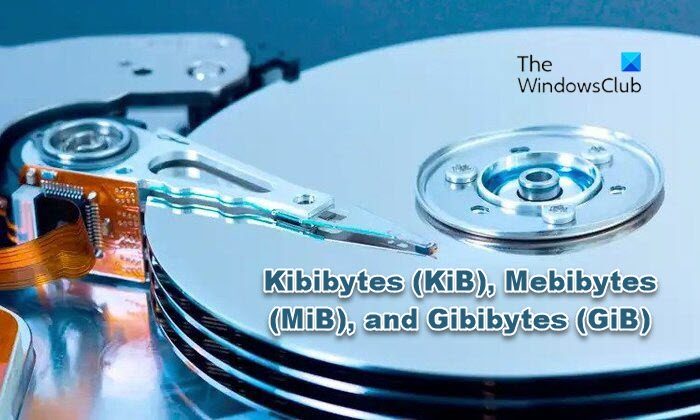They are a different set of storage units used to express/measure file sizes. On the surface, Kibibytes, Mebibytes, and Gibibytes might seem similar to Kilobytes Gigabytes, Terabytes, Petabytes and Exabytes – and often used interchangeably – but they are not the same.
The units of measurement for kilobytes, megabytes, gigabytes, etc. are all thousands of times larger than one another. This is the file storage decimal measurement system. On the other hand, the binary measuring system uses kibibytes, mebibytes, gibibytes, etc.; A mebibyte is equal to 1024 kibibytes, a gibibyte to 1024 mebibytes, and so on. The International Electrotechnical Commission (IEC) established the mebi prefix in December 1998, together with its companion binary prefixes (kibi, gibi, tebi, pebi, exbi, zebi, and yobi). Prior to then, multipliers in the binary and decimal systems were both referred to by the International System of Units (SI) metric prefixes.

Kilobytes, megabytes, etc., were used interchangeably both for measurements until the binary system’s units received names. Differences began to emerge as computing technology advanced. The decimal method was primarily used by disk drive manufacturers to mark the sizes of their hard disk drives (HDD) and solid-state drives (SSDs). Operating systems, on the other hand, frequently used the binary system to gauge storage capacity. This explains why a computer’s operating system would indicate a hard drive with a capacity of 100 MB as having only 95.37 MB.
These sorts of discrepancies led the IEC to create a set of prefixes that were intended to be used only when referring to binary measurements. Binary units being used are because they’re a more accurate unit of measurement. Computers work in binary, so a binary measurement system will always provide a better representation of file sizes.
What is Kibibyte?
Kibibyte is a binary unit for measuring memory size which is equivalent to 1024 bytes. Given that bis a is a binary quantity, this unit has been proposed by those who oppose using SI units. Hence, it is simple for anyone that doesn’t want to measure their device memory size with Kilo, a decimal memory unit.
A “kibibyte” is equal to 1024 bytes while a kilobyte naturally translates to 1000 bytes. A kilobyte has often been used to refer to both 1000 bytes and 1024 bytes but this was before the IEC came up with different storage units. Most storage manufacturers measure and label capacity in base 10. This means that 1 kilobyte = 1000 bytes; 1 megabyte = 1000 kilobytes; 1 gigabyte = 1000 megabytes, 1 terabyte = 1000 gigabytes, and so on.
Decimal units are always smaller when compared with the binary unit. Take for example; a kibibyte is bigger than a kilobyte because there are only 1000 kilobytes to 1024 in a kibibyte. It might just be a small difference when talking about a single kilobyte but as the size increases, the difference will also increase.
What is Mebibyte?
The terms mebibyte and megabyte are closely related and often used as synonyms, though technically they don’t refer to the same amount of capacity. A mebibyte is equal to 1,048,576 bytes while a megabyte is equal to 1,000,000 bytes. One mebibyte equals 1.048576 megabytes. There is a small difference between these two and one of the reasons why it’s often used synonymously.
Differences between Megabyte and Mebibyte
- Megabyte is a multiple of 1000 while Mebibyte is a multiple of 1024
- The unit symbol for the megabyte is MB while the unit symbol for the mebibyte is MiB
- A megabyte is estimated as 1,000,000 bytes while the Mebibyte is exactly 1,048,576 bytes.
- Sometime1 MB refers to both 1000 Kb or 1024 Kb while 1 MiB is always 1024 Kb
- Disk manufacturers mostly use decimal prefixes or MB while Memory manufacturers commonly use a binary prefix or MiB.
- Storage devices such as HDDs and Flash drives still use MB for calculating storage size and on the other hand, most operating systems like Windows use mebibytes to report file and storage sizes.
What is Gibibyte?
A gibibyte (GiB) is also a unit of measure of capacity used in computing. A gibibyte is equal to 1,073,741,824 bytes while a gigabyte is equal to 1,000,000,000 bytes. This means that one gibibyte equals 1.074 gigabytes and on the other hand, one gigabyte equals 0.93 gibibytes That’s a difference of about 7%. As mentioned earlier, as the storage increases, the difference between the two systems becomes magnified.
Imagine you get a 1 TB hard drive, it won’t have 1,000 gigabytes (GBs) of storage. Instead, it’ll have around 931 GBs of storage. This difference can also lead to discrepancies when viewing the same file on different operating systems. It also applies if you’re sharing files. If you receive a file from a Mac to your Windows you will notice a drop in the weight of the file.
Conclusion
Kibibytes (KiB), Mebibytes (MiB), and Gibibytes (GiB) are the binary system of calculating storage as opposed to Kilobyte (KB), Megabyte (MB), Gigabyte (GB) which is the decimal system of calculating storage. The former was created in December 1998 by the International Electrotechnical Commission (IEC) because binary units are more accurate units of measurement as a result of Computers also working in binary. It was to create a distinction because Kilobytes, Megabytes could mean two different things. But now, there is more clarity. A kilobyte (KB) is 1000 bytes and a Kibibyte is 1024 bytes and this also applies to higher storage units.
Read: Size vs Size on disk difference in Windows explained
What is the largest unit of memory?
The largest unit of memory measurement that we use is the terabyte (TB). This unit is about equal to a trillion bytes. However, there is also the Petabyte, which is 1 quadrillion bytes, but it is not frequently used.
Leave a Reply